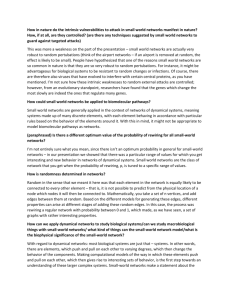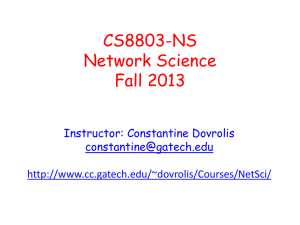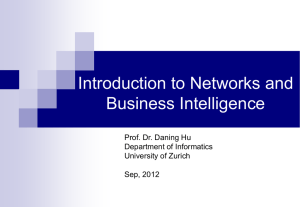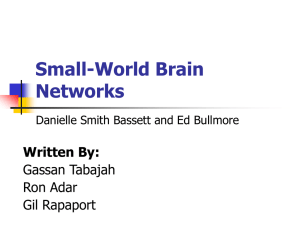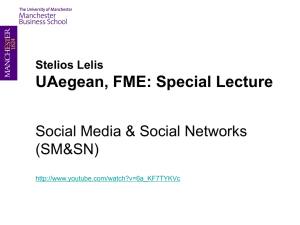Nexus: Small Worlds and the Groundbreaking Theory of Networks
advertisement
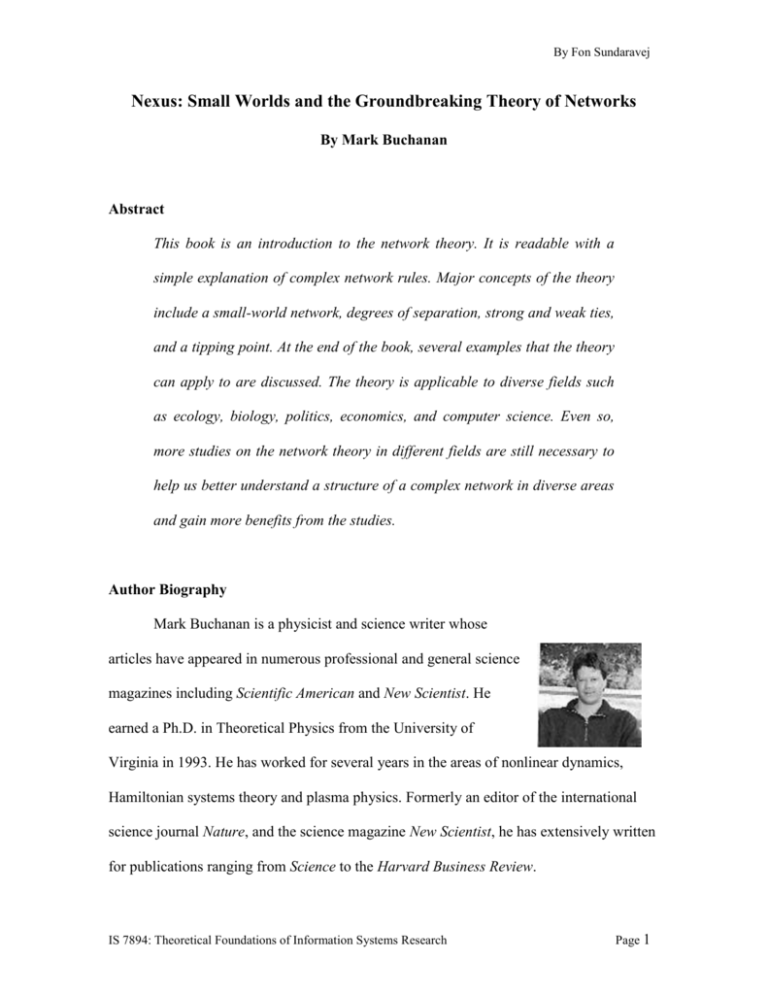
By Fon Sundaravej Nexus: Small Worlds and the Groundbreaking Theory of Networks By Mark Buchanan Abstract This book is an introduction to the network theory. It is readable with a simple explanation of complex network rules. Major concepts of the theory include a small-world network, degrees of separation, strong and weak ties, and a tipping point. At the end of the book, several examples that the theory can apply to are discussed. The theory is applicable to diverse fields such as ecology, biology, politics, economics, and computer science. Even so, more studies on the network theory in different fields are still necessary to help us better understand a structure of a complex network in diverse areas and gain more benefits from the studies. Author Biography Mark Buchanan is a physicist and science writer whose articles have appeared in numerous professional and general science magazines including Scientific American and New Scientist. He earned a Ph.D. in Theoretical Physics from the University of Virginia in 1993. He has worked for several years in the areas of nonlinear dynamics, Hamiltonian systems theory and plasma physics. Formerly an editor of the international science journal Nature, and the science magazine New Scientist, he has extensively written for publications ranging from Science to the Harvard Business Review. IS 7894: Theoretical Foundations of Information Systems Research Page 1 By Fon Sundaravej Introduction A psychologist, Stanley Milgram, initiated the lost letter technique which later became a concept of the six degrees of separation. This concept implies to a characteristic of our social networks that everyone in the world is separated by only six other people. From this finding, Duncan Watts and Steve Strogatz, two mathematicians from Cornell University, discovered a theory of the small-world networks. This theory was soon applied to different areas ranging from biology, ecology, economics, politic, computer science, etc. Chapter 1: Strange Connections The small-world networks by Watts and Strogatz is simply a graph that contains a network of dots connected by lines. The basic idea behind this diagram is to explain the structure of a social network that formulates a small world. The Oracle of Kevin Bacon game (http://www.cs.virginia.edu/oracle) was invented by two graduate students from the University of Virginia to imitate a social world of Hollywood actors. The game reveals that the social network of Hollywood actors can be described as a small-world network, indicated by a small number of links from all actors to Bacon. This result refers to our social network as a small-world network. Chapter 2: The Strength of Weak Ties In a social network, there are two types of connectors: strong and weak ties. A familiar or close person such as a family member, friend, or co-worker is considered as a strong tie, whereas an unfamiliar person is a weak tie. The author claims that a secret of the small-world networks or six degrees of separation is the performance of a weak tie that IS 7894: Theoretical Foundations of Information Systems Research Page 2 By Fon Sundaravej acts as a social bridge or crucial connection tying networks together. A network with clustering connections does not have a small-world property. Even though, a strong-tie connector is eliminated from networks, networks can still be connected as long as a weaktie connector is not omitted. Chapter 3: Small Worlds A technique to create a small world is to add some random links into a network. From an experiment by Watts and Strogatz, with a very few random links added to a clustered network, the degrees of separation can be tremendously reduced. This phenomenon happens because an added random link acts as a shortcut between distant points. In an ordered network, in contrast, moving from one point to another may take several steps. Chapter 4: Brain Works How a human brain works represents a small-world network. The brain is an assembly of distinct modules. Each module is responsible for a different basic function of perception, for instance, speech, vision, emotion, language, etc. These modules are connected in order to coordinate overall brain activities. Many Dendrites or neuron’s receiving channels link nearby modules that perform the same function, while few Axons are longer channels that connect to more distant modules. If some Dendrites are damaged, a person still can talk, see, or feel. If Axons are destroyed, however, brain may not perform some functions. IS 7894: Theoretical Foundations of Information Systems Research Page 3 By Fon Sundaravej Chapter 5: The Small-World Web The Internet is considered as a redundancy network. A major benefit of a redundancy network is its flexibility. That is, if a route to transmit data is destroyed, the network computers still can reroute the messages to the destination. The Internet is also proved to be a small-world network because tracing a connection between computers is not more than ten links. A Webpage can reflect a random network with a different number of hyperlinks on each page. There are a few Web pages that operate as a hub or contain a lot of links connected to numerous Websites, while most Web pages contain approximately three to four links per page. This pattern refers to a power law, which means that each time the number of links doubles, the number of Web pages with that many links becomes less by about five times. A logarithm is used to measure a diameter of a Web page or a distance between documents. An experiment verifies that even though new Web sites are continually established, the number of clicks from one document to another is raised only from about 19 to 21. Chapter 6: Accidental Science The Internet has a complicated structure. There is no regular framework like other scientific experiments such as water heated in a pan or sand shapes after a disturbance. These types of experiments have orchestrated historic events that can predict the formation of a future pattern. Even if the Internet growth is truly random, its unorganized evolution establishes that the Internet shares a similar globally organized pattern. IS 7894: Theoretical Foundations of Information Systems Research Page 4 By Fon Sundaravej Chapter 7: The Rich Get Richer The small-world networks or six degrees of separation can be summarized into two types: egalitarian and aristocratic. The egalitarian type has been explained by Watts and Strogatz. They believe that the network does not grow and each connector in the network links to almost equal number of other connectors. In contrast, the aristocratic type is explicated by Albert-Laszlo Barabasi, Reka Albert, and Mark Gronovetter. They consider that a network is complex with some connectors acting as a hub to dominate the network. A key characteristic of the aristocratic network is the rich get richer pattern. A Website is an example. Generally, a Website tends to link to popular sites that contain a lot links. As such, popular sites gain more connections. However, it is also possible that a popular site loses its name recognition when time passes and its connections to other sites become less until below a tipping point or the point that differentiates between two stages. Chapter 8: Costs and Consequences From the concept of a tipping point, an aristocratic network can be transformed to the egalitarian one. An airport hub is a case. An airport hub allows a high volume of travelers to diverse cities. However, a too congested airport hub results in flight delays. Many airlines will gradually vanish to other less congested airports. This occurrence can also apply to a computer network. If a data transfer encounters congested traffic, the congested route can be avoided and the data are rerouted to a IS 7894: Theoretical Foundations of Information Systems Research Page 5 By Fon Sundaravej different path. However, for a network safety issue, redundancy of a network is not enough. A network protection such as firewall or data encryption is needed. Chapter 9: The Tangled Web Chapters 9 to 12 demonstrate examples of small-world networks in various areas. Chapter 9 is a small-world network in ecology. An ecosystem has a complex food-web network which is unstable even with a small disturbance. Destroying only one type of species wildly and rapidly affects the entire community. A proof illustrates only two or less than ten degrees of separation in an ecosystem. The ecosystem can be described as an aristocratic small-world network. The predator that eats only one other specie is perceived as a strong connector in the network. If this predator is eradicated, the entire network will be disturbed. Chapter 10: Tipping Points Chapter 10 applies the theory of networks to sociology. The notion that ideas, rumors, crimes, and other influences spread through a society is explored. Meme is a genetic element to the logic of spreading or imitating ideas, catch-phrases, fashions, etc. If Meme continues its existence, its stage will be above the tipping point. On the contrary, if Meme disappears, its position will be under the tipping point. If Meme is on the critical stage or balance point, this means it is changing between two different conditions. IS 7894: Theoretical Foundations of Information Systems Research Page 6 By Fon Sundaravej Chapter 11: Breaking Out Small-World Style This chapter relates the small-world networks to biology. The spread of AIDS epidemic has strongly existed in the past fifteen years. It is believed that the origin of AIDS is in Africa and it has lasted for more than a half century. The disruption of post colonial Africa is considered as a major cause of the disease expansion. Soldiers, doctors, nurses, and many other people traveled to Africa, while more Africans departed their country by newly constructed communication channels such as trains or roads. However, if an infected person has only one sexual partner, the disease will not spread so rapidly. Until one day, the disease will be below a tipping point and disappear. However, the truth is opposite. Infected people have more than one sexual partners, especially prostitutes. This results in a continuing existence of AIDS. To control AIDS, we should concentrate on the group of strong tie patients who have a sexual contact with many people rather than the weak tie group. Chapter 12: Laws for the Living The last example of the theory of networks applies to economics. Wealth can flow within a network when someone purchases goods and services or earns a salary. Normally, in a society, there are few rich people but many poor ones. Wealthy people tend to get richer, while meager people remain poor. Rich people have a capability to purchase more lands or do a huge investment to earn more money than poor people. Taxation, as a result, is used as a mechanism to erode the difference in wealth of people in a society. However, there is a probability of a collapse of wealth. This represents that a tipping point exists in IS 7894: Theoretical Foundations of Information Systems Research Page 7 By Fon Sundaravej economics. In addition, a collapse of wealth can dramatically transform a society such as a shift of political power to a small group of wealthier people. Chapter 13: Beyond Coincidence An aim to study a science of complexity is to discover patterns in every kind of complex network, ultimately to better understand ourselves and our world. The consequence of the study also proves that the small-world networks or small degrees of separation found in a complex society such as the human brain, food webs, distribution of wealth, or Internet is not simply a coincidence. The main characteristic of a small-world network is a random system that still remains a high degree of clusters with few weak ties to connect the entire network together. Both strong and weak ties play a significant role in a small-world network. A group of strong ties has a history and frequent interaction, share the same norms, and have a dense relationship, while weak ties keep a relationship with the rest of the community and access diverse information. In conclusion, a small-world network can gains benefits from both ties. Author Biography References http://www.randomhouse.com/crown/catalog/results.pperl?authorid=3655 http://www.orionbooks.co.uk/9827-0/Author-Mark-Buchanan.htm http://www.informatics.indiana.edu/colloquia/default.asp?archive=true&id=523&st=&year =2005 IS 7894: Theoretical Foundations of Information Systems Research Page 8
